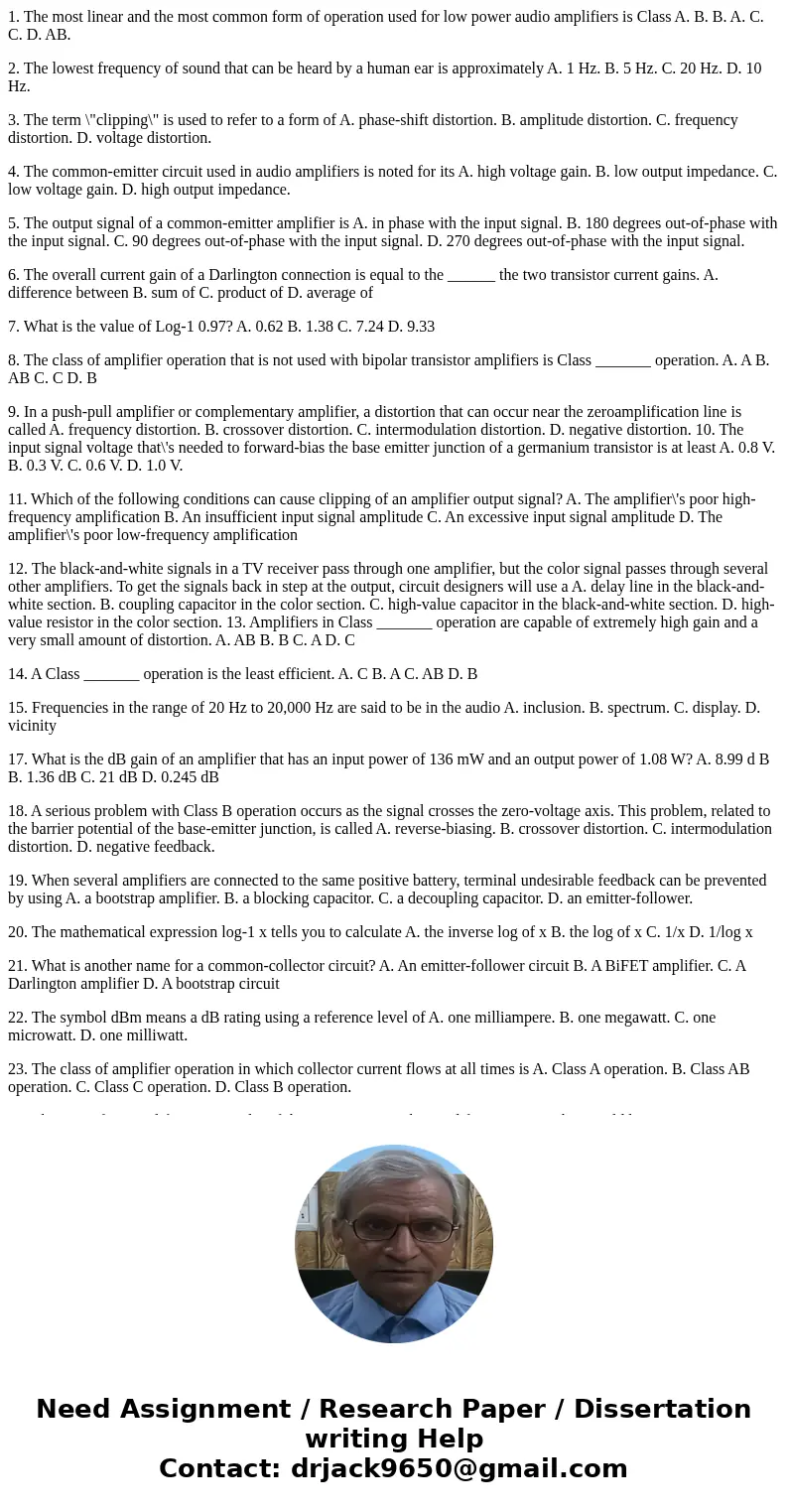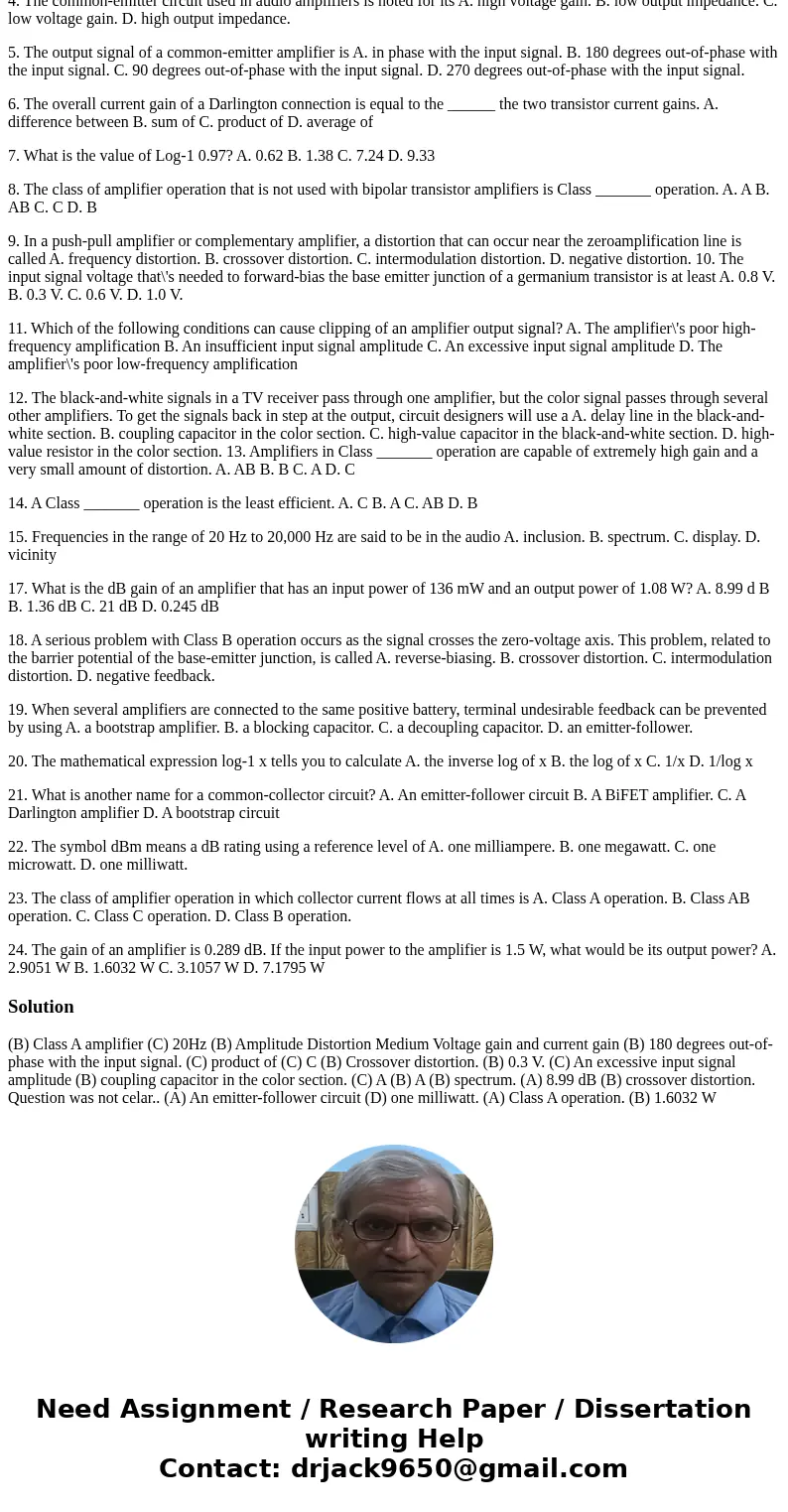1 The most linear and the most common form of operation used
1. The most linear and the most common form of operation used for low power audio amplifiers is Class A. B. B. A. C. C. D. AB.
2. The lowest frequency of sound that can be heard by a human ear is approximately A. 1 Hz. B. 5 Hz. C. 20 Hz. D. 10 Hz.
3. The term \"clipping\" is used to refer to a form of A. phase-shift distortion. B. amplitude distortion. C. frequency distortion. D. voltage distortion.
4. The common-emitter circuit used in audio amplifiers is noted for its A. high voltage gain. B. low output impedance. C. low voltage gain. D. high output impedance.
5. The output signal of a common-emitter amplifier is A. in phase with the input signal. B. 180 degrees out-of-phase with the input signal. C. 90 degrees out-of-phase with the input signal. D. 270 degrees out-of-phase with the input signal.
6. The overall current gain of a Darlington connection is equal to the ______ the two transistor current gains. A. difference between B. sum of C. product of D. average of
7. What is the value of Log-1 0.97? A. 0.62 B. 1.38 C. 7.24 D. 9.33
8. The class of amplifier operation that is not used with bipolar transistor amplifiers is Class _______ operation. A. A B. AB C. C D. B
9. In a push-pull amplifier or complementary amplifier, a distortion that can occur near the zeroamplification line is called A. frequency distortion. B. crossover distortion. C. intermodulation distortion. D. negative distortion. 10. The input signal voltage that\'s needed to forward-bias the base emitter junction of a germanium transistor is at least A. 0.8 V. B. 0.3 V. C. 0.6 V. D. 1.0 V.
11. Which of the following conditions can cause clipping of an amplifier output signal? A. The amplifier\'s poor high-frequency amplification B. An insufficient input signal amplitude C. An excessive input signal amplitude D. The amplifier\'s poor low-frequency amplification
12. The black-and-white signals in a TV receiver pass through one amplifier, but the color signal passes through several other amplifiers. To get the signals back in step at the output, circuit designers will use a A. delay line in the black-and-white section. B. coupling capacitor in the color section. C. high-value capacitor in the black-and-white section. D. high-value resistor in the color section. 13. Amplifiers in Class _______ operation are capable of extremely high gain and a very small amount of distortion. A. AB B. B C. A D. C
14. A Class _______ operation is the least efficient. A. C B. A C. AB D. B
15. Frequencies in the range of 20 Hz to 20,000 Hz are said to be in the audio A. inclusion. B. spectrum. C. display. D. vicinity
17. What is the dB gain of an amplifier that has an input power of 136 mW and an output power of 1.08 W? A. 8.99 d B B. 1.36 dB C. 21 dB D. 0.245 dB
18. A serious problem with Class B operation occurs as the signal crosses the zero-voltage axis. This problem, related to the barrier potential of the base-emitter junction, is called A. reverse-biasing. B. crossover distortion. C. intermodulation distortion. D. negative feedback.
19. When several amplifiers are connected to the same positive battery, terminal undesirable feedback can be prevented by using A. a bootstrap amplifier. B. a blocking capacitor. C. a decoupling capacitor. D. an emitter-follower.
20. The mathematical expression log-1 x tells you to calculate A. the inverse log of x B. the log of x C. 1/x D. 1/log x
21. What is another name for a common-collector circuit? A. An emitter-follower circuit B. A BiFET amplifier. C. A Darlington amplifier D. A bootstrap circuit
22. The symbol dBm means a dB rating using a reference level of A. one milliampere. B. one megawatt. C. one microwatt. D. one milliwatt.
23. The class of amplifier operation in which collector current flows at all times is A. Class A operation. B. Class AB operation. C. Class C operation. D. Class B operation.
24. The gain of an amplifier is 0.289 dB. If the input power to the amplifier is 1.5 W, what would be its output power? A. 2.9051 W B. 1.6032 W C. 3.1057 W D. 7.1795 W
Solution
(B) Class A amplifier (C) 20Hz (B) Amplitude Distortion Medium Voltage gain and current gain (B) 180 degrees out-of-phase with the input signal. (C) product of (C) C (B) Crossover distortion. (B) 0.3 V. (C) An excessive input signal amplitude (B) coupling capacitor in the color section. (C) A (B) A (B) spectrum. (A) 8.99 dB (B) crossover distortion. Question was not celar.. (A) An emitter-follower circuit (D) one milliwatt. (A) Class A operation. (B) 1.6032 W

 Homework Sourse
Homework Sourse